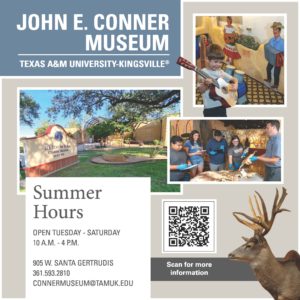Coco got it right. “Our memories, they have to be passed down by those who knew us in life – in the stories they tell about us.”
Día de los Muertos—the Day of the Dead—was celebrated in Kingsville from Nov. 1 to Nov. 2 at the recently bought Totes & Things building located at 400 E. Kleberg Ave. Community members, natives, alumni and current students from Texas A&M University-Kingsville helped celebrate Día de los Muertos which honors the dead with celebrations that combine indigenous rituals with Catholicism.
Día de los Muertos recognizes death as a natural part of the human process. It is believed that on Nov. 1 and Nov. 2 loved ones who have passed away can visit their family members in the living realm. For Día de los Muertos living family members and friends celebrate the lives of loved ones by setting up altars, making food, drinks, throwing parties, and participating in activities their loved ones enjoyed when they were alive.
Many citizens of Kingsville set up altars in honor of various family members who have passed. Names such as Garza, Alvarado, Flores, Padilla, Nuestras, any many others surrounded picture frames, flowers, foods, candles, and other ofrendas and gifts. Family members cried, laughed, smiled and basked as people of all ages walked around admiring and honoring their loved ones.
“It’s so amazing to see so many people here. I was not expecting this. Isn’t it great,” Maggie Salinas, a prominent community member of Kingsville said.
The most familiar symbol of Día de los Muertos are calacas and calaveras (skeletons and skulls), which appear as candied sweets, masks, makeup and as dolls. Calacas and calaveras are almost always portrayed as enjoying life, often in entertaining situations. Students from A&M-Kingsville and local artists participated in this heartfelt event by creating artwork that honors this holiday. Joshua Vela, a professional painter from Corpus Christi, created various pieces of artwork showcasing calaveras, fictional creatures, and images that pop into his mind for this event. Vela uses a unique technique when creating art that he refers to as “planet pouring” where he pours different colored paint onto a canvas and manipulates the paint with plastic art tools.
“I love Día de los Muertos. But I like darker stuff. My stuff is what I see when I close my eyes,” Vela, a professional painter, said.
Some students drew or created calaveras, some sketched and painted beloved celebrities like Selena, while others took a more personal route and showcased artwork of their fallen family members.
“There’s a lot of meaning behind this painting. It took me a couple days to sketch it out. It was hard,” said Jacqueline Zamora, an art major while looking at her painting titled “Esteban.”
Most of the time Día de los Muertos is mistaken as “Mexican Halloween.” It is no such thing. David Thibodeaux, the owner of the Totes & Things building, praises Disney’s Pixar film, Coco for helping explain the truth behind this inspiring holiday.
On the surface, Coco is the story of a young boy named Miguel, who is accidentally transported to the Land of the Dead, where he seeks the aid of his great-great-grandfather to help him return home. The film opens on Día de Muertos during which Miguel’s family, like so many in Mexico, gather round to make offerings and remembrances to their dead ancestors.
The relationship between the living and the dead is a key theme in Coco and introduces the concept of the “three deaths” that is derived from traditional Mexican beliefs. The “first death” is the physical one, the death of the body. The “second death” is more of a natural one, when the body is laid to rest in the earth and the “third death” is the moment the last memory of you fades. Those who reside in the Land of the Dead can do so only as long as there is someone to remember them in the Land of the Living; once that last memory is lost our loved one’s fade away, forever. Día de Muertos helps to delay that final death.
It’s much more complicated and meaningful than a simple “Mexican Halloween.” But since the movie’s debut more people finally understand the concept of Día de los Muertos and appreciate this disregarded holiday.
“It’s really about educating because I think there are these misnomers about what it’s truly about. When people see the skeletons they’re put off by it but it’s not really what it means or what it’s about. You’re honoring your loved ones, that’s the bottom line. Now after the movie Coco, that was a perfect example because it explained it beautifully and it did it in such a beautiful story form. And so I was really thankful for that movie because I refer a lot of people to it when I try to explain it to them and try to make them realize it’s really a mixture of cultures and religions. It’s Mayan, Indian based and then Catholicism met together so they did not give up a lot of their Indian and traditional beliefs, so they just kind of meshed it together. So it’s really not a Christianity thing and it’s really not just a pagan thing, it’s a little bit of both,” Thibodeaux said.
